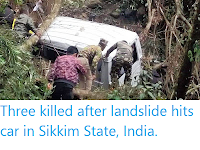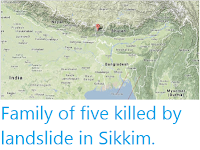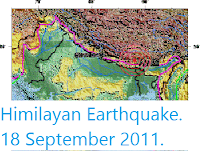Two Indian soldiers have been killed after being caught in a avalanche while on a snow clearing patrol in Sikkim State on Thursday 14 May 2020. Lieutenant Colonel Robert T A and Sapper Sapala Shanmukha Rao were part of a patrol of eighteen soldiers who were caught in the avalanche in the Lugnak La Pass, about 5000 m above sealevel when they were caught by the avalanche. The other members of the patrol have been evacuated safely and are unhurt. Avalanches are a particular hazard in the high Himalayas at this time of year, as the spring thaw starts to weaken layers of snow that have built up over the long winter.
Lieutenant Colonel Robert T A, killed in an avalanche in Sikkim State, India, on 14 May 2020. Maram Naga/Facebook.
Avalanches are caused by the mechanical failure of snowpacks;
essentially when the weight of the snow above a certain point exceeds
the carrying capacity of the snow at that point to support its weight.
This can happen for two reasons, because more snow falls upslope,
causing the weight to rise, or because snow begins to melt downslope,
causing the carrying capacity to fall. Avalanches may also be triggered
by other events, such as Earthquakes or rockfalls. Contrary to what is
often seen in films and on television, avalanches are not usually
triggered by loud noises. Because snow forms layers, with each layer
typically occurring due to a different snowfall, and having different
physical properties, multiple avalanches can occur at the same spot,
with the failure of a weaker layer losing to the loss of the snow above
it, but other layers below left in place - to potentially fail later.
Diagrammatic representation of an avalanche, showing how layering of snow contributes to these events. Expedition Earth.
See also...
Follow
Sciency Thoughts on Facebook.







